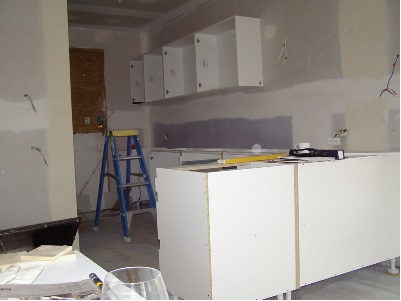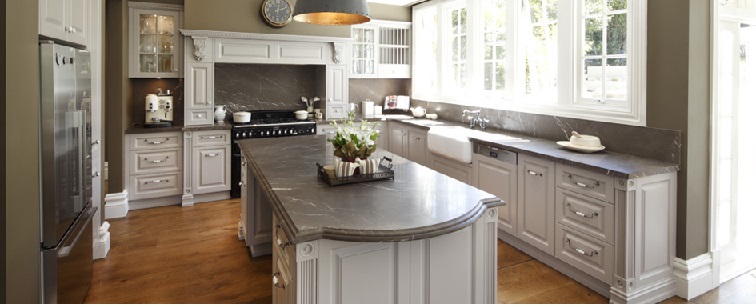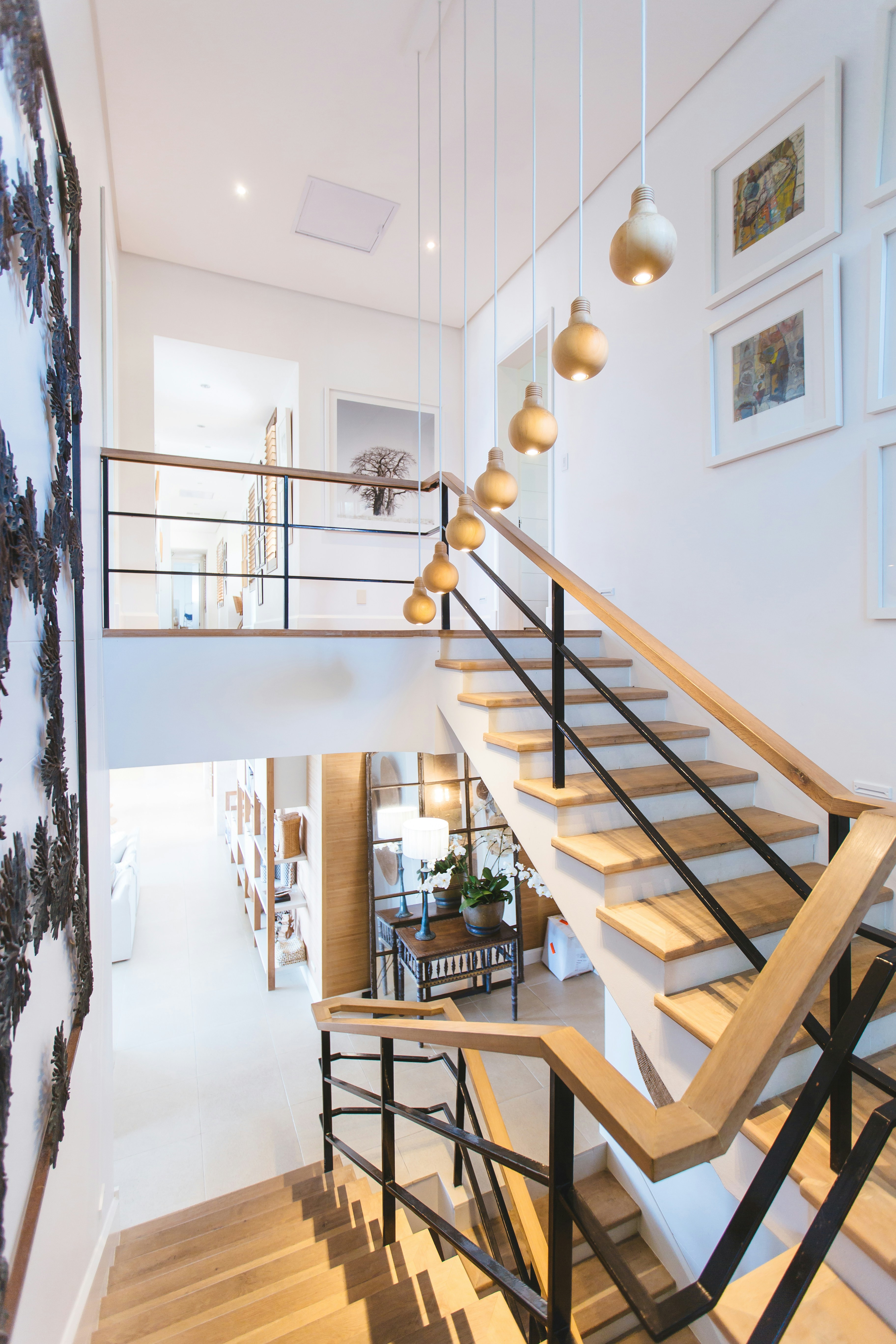Once the heart of the home, the living room has gracefully passed the torch to the kitchen in the modern age. Homeowners now pour their resources into crafting a stunning new kitchen, not just for personal enjoyment but also with an eye on the added property value it brings when selling down the road.
Embarking on the journey of selecting components for your kitchen is both thrilling and nerve-wracking. It's a fun process, but navigating the maze of what to focus on and what to avoid requires ample time and research.
To ease your kitchen quest, we present the Ultimate Guide to Buying a New Kitchen – a comprehensive resource packed with all the information you need to make the perfect choices for your home. Whether this is your inaugural kitchen re-fit or you're a seasoned pro at the game, dive into the wisdom shared by seasoned kitchen professionals. Let's cook up a plan for your dream kitchen!
Contents
Tips For Choosing Your New Kitchen
Planning Your New Kitchen
How To Measure Your Existing Kitchen
Types of Kitchens
Types of Worktops
Picking Out Your Kitchen Frontals
Paying For Your New Kitchen
The Kitchen Installation Process
Checking Your Supplier Contract

Tips for choosing your new kitchen
With so many designs, styles and price ranges to choose from you need to take the time to research and weigh up all of your options before you commit to anything.
- A good starting point is to begin looking through a few of the specialist kitchen magazines. This will give a sense of what you may be interested in, helping you to narrow down the many choices. From there, visit at least a handful of different showrooms by yourself before you commit to any appointments with sales people or designers. Naturally, they want to close a deal as quickly as possible, and at this stage you do not need more voices adding to the confusion.
- In the showrooms take a good look around at the kitchens by opening the cupboards and drawers and inspecting the height, depth and space each one can provide. This will help you make a list of the ideal items you want in your new kitchen. Whether it’s a dishwasher, wine racks, soft-close drawers and doors, split level cooking or anything else.
- Getting the advice of a kitchen specialist is a must before coming to any final decisions. Their experience and knowledge should help prevent you from making any big mistakes.
- Countless homeowners have told us they have made their selections based solely on what looks good, how it blends in with their home furnishings in-terms of colour, style, style, while also staying within budget. All of these things are important, of course. However, too often the durability, strength and maintenance requirements of the kitchen are overlooked when it comes to purchasing and these play an essential role in the longevity of your kitchen.
- Another point to take note of is related to kitchen products. When purchasing remember that many will come with additional manufacturer guarantees. It makes sense to shop around before investing to find out what benefits they provide.
- Products that are certified by the Forest Stewardship Council (FSC)or Programme for the Endorsement of Forest Certification (PEFC) are recommended. Their sustainable programs ensure the materials used are eco-friendly. In fact, whenever you purchase any timber based furniture, always ensure it supports responsible forestry.
Planning your new kitchen
 Planning is everything when it comes to buying a new kitchen. This relates not only to the products you choose for the space but also the layout or shape of where the kitchen will go, the fitting and how much use you expect to get out of it.
Planning is everything when it comes to buying a new kitchen. This relates not only to the products you choose for the space but also the layout or shape of where the kitchen will go, the fitting and how much use you expect to get out of it.
Spending big money doesn’t guarantee a perfect kitchen without good planning behind it. The opposite is equally true for kitchens paid for at the lower end of the market, which when well planned, can look absolutely fantastic.
Important questions to ask yourself include:
- How much use will you get from your kitchen every day?
- Will you be using it just to prepare food or also to double as a dining room?
- Apart from cooking, what else do you use the room for?
- Do you have children or pets? This will have an impact on usage, as well as durability and safety issues.
- Will there be a lot of foot traffic passing through the room (will there be an external door to a back garden or garage)?
- Are you happy with the amount of counter space in your current kitchen, or do you often find yourself moving between different areas?
- Also give thought to how many people will normally be using the room each day, whether you have enough storage, what sort of appliances you many need and whether or not seating space is required.
Planning the kitchen layout
Like any room in the house, the main consideration that has to be taken into account is ensuring the layout is efficient enough for you to get the most use out of it.
This means making sure food preparation, storage and cooking areas are not too far apart from each other. Having a piece of worktop between the hob and the sink is also a good idea. Try to keep the fridge close to the entrance of the kitchen which will making shopping a bit easier. You should also avoid placing the fridge near to a hob or oven as the temperature difference can mean the refrigerator does not operate efficiently enough. Although, integrated appliances are less likely to be affected.
Points to consider:
 - The most important features in the room are where the sink, hob and preparation areas will be. Once you have an idea of where you want these to be, make sure there is a short walking space between each one. It also helps to get a feel for what feels right to you. For example, do you want the sink to the left or right of the hob? Do you really need the sink installed under the window? You may prefer to have more natural light when you are preparing food. Think about if you require a double oven, or if a single oven and a combination microwave might be a better choice.
- The most important features in the room are where the sink, hob and preparation areas will be. Once you have an idea of where you want these to be, make sure there is a short walking space between each one. It also helps to get a feel for what feels right to you. For example, do you want the sink to the left or right of the hob? Do you really need the sink installed under the window? You may prefer to have more natural light when you are preparing food. Think about if you require a double oven, or if a single oven and a combination microwave might be a better choice.
- Considering the above will have a direct impact on where each of the service points for gas, electric and water can be positioned. Keep in mind where the existing points are in your current kitchen, as the time and money it will take to move these can quickly add up due to all of the additional re-plumbing and rewiring. This also applies to an existing ventilation points currently in the kitchen.
- In most cases sinks are installed up against an outside wall underneath a window. This is due to the position of the external drain. It also provides a good source of natural light, while also giving you a better view when doing the mundane things like washing up in the kitchen. Although, if this doesn’t matter to you and you have the option to place the sink somewhere else, it is worth giving consideration to.
How to measure your kitchen
When you visit a supplier to choose your kitchen, having the exact measurements to hand is absolutely essential. These should be in metric, including the shape of the room, marking out where all the existing service and ventilation points are, along with windows and doors. To make sure you have done this correctly, choose a supplier that offers a free survey so they can cross check your dimensions.
Here are 7 easy-to-follow steps:
- Get the overall room layout by sketching it on paper. All you really need is the general shape.
- Indicate where all the openings are in the room – any doors, windows, archways and hatches, marking down the height and width of each. Make sure to include the opening swing of the doors too.
- Note down any fixed obstacles that cannot be moved. This could be items such as radiators, boilers, meters and any electric, water, gas and mains services.
- Measure between each fixed point, meaning the walls, doors and windows. Start from one corner of the room and work round clockwise. When measuring windows and doors you must include frames and architraves, as well as the distance from the floor to the bottom of the windows.
- Now measure the fixed obstacles in the room – radiators, boilers etc. Ensure the depth, height and width is included for each. Also mark down the obstacle heights and their distance from the floor e.g. H=500mm F=1000mm
- The main services such as gas, electric and water need to be measured next. This is done by measuring from the nearest fixed point on the sketch to the centre line of each service. Make sure to include sockets, water, gas and TV points. When it comes to larger items like gas meters and radiators also include their width and height from the floor.
- Measure the heights of the ceilings. Do this at 2 or 3 points in the room to ensure the measurements are consistent. If you come across any obstacles such as a landing or stair slope, put this down onto the sketch.

Types of kitchens
There are five different types of kitchen you can choose from – custom built, rigid construction, flat pack, fully built or free-standing. They all have their own advantages and disadvantages and will also pay a big role in how much you will pay.
Custom built kitchens
These are the ultimate kitchens in many senses as they are tailored to your exact needs in almost every way. There are some kitchen suppliers who use the term to describe kitchens that aren’t strictly one-off designs, although they do feature a range of colours, materials and varying shapes.
There is one big difference between a custom built kitchen and those that are constructed using a range of fixed dimension manufactured cabinets that have been tailored to suit your home. That is, when it comes to unusually shaped rooms, a well thought out custom design can find a way to make it work well. You will have to be prepared to pay for this sort of luxury, as they are at the premium end of the scale and installation generally takes a lot longer.
Rigid construction kitchens
These are factory built kitchens that are constructed using dowels and glue, or dry assembled using a method called ‘metal cam and dowel’ fittings. There are a large selection of cabinets available in this option, which provides homeowners with greater flexibility in terms of design.
Rigid kitchen carcases can usually be installed a lot quicker as they arrive fully assembled. Good forward planning is needed here because if you are not ready for installation once delivered they will take up a lot of room in the meantime. Chipboard panels and MDF are the typical materials used for rigid construction kitchens, making them a more affordable choice for many.
Flat pack kitchens
 Flat pack kitchens have evolved over the past couple of decades as a way to respond to the growing DIY culture in this country. It is a kitchen far more commonly associated with the UK than other areas of Europe and the nature of their construction means a lot more people are able to afford them.
Flat pack kitchens have evolved over the past couple of decades as a way to respond to the growing DIY culture in this country. It is a kitchen far more commonly associated with the UK than other areas of Europe and the nature of their construction means a lot more people are able to afford them.
The size of cabinets is generally a lot smaller, although there has been a bit of an improvement in this area of the past few years. Similar to rigid carcases, flat pack kitchens are manufactured using MDF and chipboard panels.
Fully built kitchens
Fully-fitted kitchens are designed to ensure you make the most of the space available in the room, maximising both work and storage areas. They can either be suppled in a rigid carcase, or as a flat-pack option. Depending on the budget available, fully-fitted kitchens can be installed by the supplier or the customer.
The pre-assembled units are available in various shapes and sizes and in many cases provide extremely useful corner solutions. Installing a quality fully-fitted kitchen will add real value to your home, but remember, taking it with you won’t be so easy.
Free-standing kitchens
These are kitchens that are non-fitted, consisting of individual pieces of furniture that are used for specific tasks. It is becoming one of the most popular choices for modern homes as it provides a more informal and de-structured aesthetic.
Free-standing kitchens are better suited to larger rooms as they do not make the best use of storage space because they have not been specifically designed for the room. On the other hand the big advantage is the pieces of furniture can be easily moved and used elsewhere, if needed.
Types of worktops
Worktops will play a big role in creating the look, feel and overall atmosphere inside the kitchen once it has been installed. They come in a variety of different materials, including solid wood, manmade boards, natural or synthetic veneers, or even stone and steel if required.

One of the most important things to take into consideration here is the reason why these are being purchased. Take into account their durability, strength, size and ongoing maintenance requirements. Over time they will take the brunt of the wear and tear that happens in the kitchen.
They will come into contact with water, oils, juices, fats, knives, hot pots and pans and whole list of utensils. This is why it makes sense to buy the best and most durable that fits into your budget.
Solid wood worktops
Installing wooden worktops instantly adds character and style to the room. The thing to remember is that wood will scratch, cut and pick up stains if not cared for properly. Hot pots and pans can burn a wooden worktop and it is best to use chopping boards instead of preparing food directly on the surface itself.
While solid wood worktops do require ongoing maintenance to keep them in good condition, using the correct refinishing techniques will repair even the slightest surface damage. Solid wood also works well as a contrast against other types of material, for example if you use it for a breakfast bar, while the remaining surfaces are made from laminate. This is an expensive choice both short and long-term, but one that really adds value to the kitchen.
Solid surface worktops
A combination of minerals and solid synthetics with a colour pigment engrained throughout make up the ingredients of a solid surface worktop. It is one of the most common types found in homes due to their relative low cost, durability and low maintenance required. They are usually repairable if in need of repair and are manufactured in a broad range of colours and styles.
What homeowners also like about solid surface worktops is the almost invisible joints that create a seamless look across the kitchen. This keeps the room looking clean, elegant and pleasing to the eye. In some cases the same material can also be used on sinks, cabinet doors, handles and wall cladding panels to create a matching look.
Granite or marble worktops
Using natural stone for a worktop is an expensive choice but it adds a sense of individuality to the room as most people will not have it in their homes. No one piece of marble or granite is the same, with the markings on each making it completely unique.
Compared to marble, granite is not as porous and less likely to pick up stains that will engrain into the material. The cost can prove to be prohibitive to some once all the calculations have been done, especially when it comes to larger pieces being installed. Consider whether you can use granite or marble in smaller areas of the kitchen, such as around the sink or hob, while using laminate worktops elsewhere, which will help keep the price down.
Tiled worktops
Tiles are also very easy to maintain and the colour and style options available are almost endless. This also means when it comes to cost there is wide scale, but there is usually something available to suit both aesthetic preferences and budgetary limits.
A quick wipe down is all that is needed for the surface of the tiles, but the grout end edging materials require a bit more care and attention to prevent them from discolouring or staining. Tile worktops are straightforward to repair if cracked or broken, although this should be taken care of quickly as damage can spread to other tiles if no attended to.
Laminate worktops
One of the most popular choices due to the low price and extensive choice of colours and finishes making it an easy fit for most interior designs. Laminate worktops are hardwearing and easy to install, although a big downside is they cannot be refinished if they are damaged at some point.

Laminate worktops are also of the most hygienic thanks to the coating that seals the MDF core, making it far harder for germs and bacteria to fester. Maintenance wise all they require is a wipe down with a wet cloth and detergent once a week to keep it germ-free.
Picking out your kitchen frontals
Cabinet doors, or frontals, are part of the design that will greet you every time you enter room, so you have to be careful on the style and design you pick out. Although it sounds surprising, drawer and door fronts are usually more expensive than the actual cabinets themselves. Two other key factors to pay attention to are maintenance and durability, as they will continually be opened and closed over the years.
The good news is that most kitchen carcases are manufactured to standard sizes making it easy to replace the frontals if you tire of the look. There are a variety of different finishes and materials, which each having their pros and cons.

Solid wood frontals
Typically a mixture of solid stiles and rails with a veneered centre panel to ensure a stable performance. A veneer will usually be cheaper and unlikely to feel the effects of any heat or damp over time. Solid wood also varies from one piece to another as it is a natural material, so it won’t look completely uniform. Finishes available include painted, gloss lacquered, waxed, colour washed and stained.
Laminate frontals
These consist of synthetic surfacing materials that are made in sheets using layers of resin-impregnated papers. You can have any sort of decorative effect on the top surface and it is one of the most durable choices making it perfect for kitchen environments. Laminate doors are almost completely maintenance free, and with all the combinations of texture, style, colour and finish available, you can see why it is so often the preferred choice.
Stainless steel frontals
Stainless steel is slowly becoming a more popular choice with homeowners. This may be because it is the easiest material available to clean, as well as being durable and completely hygienic. A downside is they look quite clinical when installed and doesn’t provide much character. Stainless steel doors are also one of the more expensive options around.
High gloss frontals
High gloss acrylic, PVC or lacquered doors can be bought in any number of colours and are currently going through a period of real popularity. When choosing darker colours, such as black or navy, it is more likely to reveal finger prints and any other marks and scuffs left on the material. This is why lighter colour tend to be the better option with high gloss frontals.
Paying for your kitchen
 Most suppliers will either request you pay in part or in full before delivery is made, so check with them before signing the contract to see what protection is offered should anything go wrong. For example, members of The Furniture Ombudsman (TFO) are able to provide a payment protection scheme which will ensure the customer is protected in the event of an unresolved dispute during both the sale and installation of your new kitchen.
Most suppliers will either request you pay in part or in full before delivery is made, so check with them before signing the contract to see what protection is offered should anything go wrong. For example, members of The Furniture Ombudsman (TFO) are able to provide a payment protection scheme which will ensure the customer is protected in the event of an unresolved dispute during both the sale and installation of your new kitchen.
In the scenario that you are involved with a dispute that has been referred to The Furniture Ombudsman, the supplier will be asked to pay 20% of the contract price to them. TFO will look into the complaint in more detail and if they decide that compensation is due to the customer, the money received by them will ensure the customer will get the monies owed.
The kitchen installation process
You will find that the installation of a kitchen will often be called a ‘dry fit’ which covers the following points:
- The delivery of all the accessories and units purchased
- Assembling of all the units that are then fixed to the walls, along with the alignment of the drawer and door fronts
- Worktops, plinths and cornices are installed
- Sink installation
- Removing and disposing of the current kitchen materials
- Check the supplier has already agreed to carry out any additional tiling, plumbing or decorating work if it is required. There can be a big difference in cost if this does not form part of the original contract
- Always take the time to read through the contract before putting down your signature as some will feature expensive cancellation clauses you need to be aware of
- Check with the supplier if you offer an after-sales service to double check the kitchen has been installed to your satisfaction
- A good supplier will also be third part certified for its installation service with something similar to the FIRA Gold installation certification scheme

Checking your supplier contract
With so much money being invested in your new kitchen you will need to check the contract is in order before committing your money. There are a few simple checks you can make with your supplier to make sure you avoid any problems.
- Ensure the contract includes a technical home visit before the installation begins, regardless of whether it is supply only, or supply and fit. You may be charged extra if the contract is for supply only. A site visit will identify any issues that may come up upon delivery and allow you to find a solution beforehand
- Your quote should include everything you are paying for, detailing what is due for delivery, full costs and arrival date
- Have a clear idea of the work being undertaken by the supplier. Check whether it includes additional works such as tiling, electrical installation and redecorating
- Your supplier should also give a clear timeline of how long installation will take. When the fitting stage begins you will have to expect some disruption around the home. Services such as water, gas and electric will be disconnected so appliances can be installed. This will mean finding alternative arrangements for things such as cooking and laundry during this period
- Before the fitting of your kitchen begins, the carcase will be delivered to your home and you need to make arrangements to store this somewhere in the meantime. If you have a garage then this is the most common solution. Empty all of your existing cupboards and store the contents somewhere else in the meantime. If you are a pet owner, then you might want to ask someone to look after your cat or dog while the kitchen is being fitted. Also, tell your neighbours there will be workmen coming and going for a couple of weeks and to expect some noise
- Rarely does any installation go 100% smoothly and even the best supplier will run into one or two issues that need to be resolved. This is normal given the amount of work involved in fitting a new kitchen. The supplier should highlight these to you during the fitting stage, or let you know what other solutions can be made once the majority of the fit is in place. Quite often there will be a ‘to do’ list once most of the kitchen is installed and remedial work is usually finished anywhere between 2-4 weeks after the completion date
- Once the kitchen has been installed most suppliers will ask you to sign a completion certificate. This will confirm the kitchen has been installed in full and there are no remaining issues to be resolved. If there are some areas that you are not satisfied with you can note these down on the completion certificate to highlight what is remaining
Added: October 16, 2018 13:46:02





